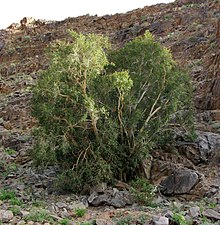Ficus cordata
| Namaqua rock fig | |
|---|---|

| |
| In the Fish River Canyon, Namibia | |
| Scientific classification | |
| Kingdom: | Plantae |
| Clade: | Tracheophytes |
| Clade: | Angiosperms |
| Clade: | Eudicots |
| Clade: | Rosids |
| Order: | Rosales |
| Family: | Moraceae |
| Genus: | Ficus |
| Subgenus: | F. subg. Urostigma |
| Species: | F. cordata
|
| Binomial name | |
| Ficus cordata | |
Ficus cordata, the Namaqua rock fig,[1] or Namaqua fig[2] is a species of fig that occurs in two disjunct populations in Africa, one in the arid southwest of the continent, and a second in the northern subtropics. In the south it is often the largest and most prominent tree,[3] and is virtually restricted to cliff faces and rock outcrops,[4] where it has a rock-splitting habit.[5]
Subspecies[edit]
The subspecies are:[6]
- F. c. cordata – southwestern Africa
- F. c. lecardii (Warb.) C.C.Berg – Senegal to central Africa[7]
Range and habitat[edit]
The nominate subspecies is native to arid western South Africa, Namibia and southwestern Angola,[4] while a second subspecies is native to Africa's northern subtropics. The nominate subspecies is found in fynbos, succulent Karoo and Nama Karoo,[4] while the northern subspecies is found in savannah, up to 1,500 m above sea level.[7]
Species associations[edit]
The nominate subspecies is pollinated by the wasp Platyscapa desertorum Compton. The wasp Comptoniella vannoorti Wiebes is an associated non-pollinator that oviposits through the fig wall.[4] The pollinator wasp of the northern subspecies, F. c. lecardii, is as yet unknown.[7]
Similar species[edit]
F. salicifolia,[8] the Wonderboom, is sometimes deemed a third subspecies of Ficus cordata, i.e. F. c. subsp. salicifolia (Vahl) C.C.Berg, but it lacks the yellowish sessile figs of F. cordata, and its range is much to the east.

References[edit]
- ^ a b Botanic Gardens Conservation International (BGCI).; IUCN SSC Global Tree Specialist Group (2020). "Ficus cordata". IUCN Red List of Threatened Species. 2020: e.T138393349A146447809. doi:10.2305/IUCN.UK.2020-2.RLTS.T138393349A146447809.en. Retrieved 19 November 2021.
- ^ "Ficus cordata". PlantZAfrica. SA National Biodiversity Institute. Retrieved 22 May 2021.
- ^ Moll, Eugene (2013). Watter Boom is dit?. ISBN 978-1-77007-832-1.
- ^ a b c d Van Noort, S., Rasplus, J. "Ficus cordata cordata Thunberg 1786". Figweb. Iziko Museums. Archived from the original on 5 November 2014. Retrieved 18 November 2014.
{{cite web}}: CS1 maint: multiple names: authors list (link) - ^ Burring, Jan. "Ficus abutilifolia (Miq.) Miq". PlantZAfrica.com. SANBI. Retrieved 16 November 2014.
- ^ "Ficus cordata Thunb". The Plant List (2013). Version 1.1. Retrieved 6 November 2014.
- ^ a b c Van Noort, S., Rasplus, J. "Ficus cordata lecardii (Warburg) C.C. Berg 1988". Figweb. Iziko Museums. Archived from the original on 29 November 2014. Retrieved 18 November 2014.
{{cite web}}: CS1 maint: multiple names: authors list (link) - ^ "Ficus salicifolia Vahl". The Plant List (2013). Version 1.1. Retrieved 6 November 2014.

